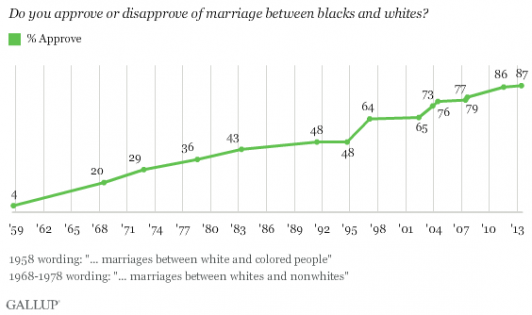With the Loving case, the Supreme Court tore down the last remaining segregation laws—those that barred whites and nonwhites from marrying and forming families together. Although it would take some time for the ruling to be fully accepted—in many southern states, court clerks continued to refuse to issue marriage licenses to interracial couples for several years after Loving—the ruling did not generate violence or massive resistance the way that the decision in Brown v. Board of Education had.
The decision played a major role in the gradual change in attitudes about interracial marriage among Americans. In 1965, 48 percent expressed support for miscegenation laws, but by 1970, only 35 percent did so. Approval of interracial marriage has risen from 4 percent in 1958 to 87 percent today. The number of interracial couples in the United States has increased dramatically too since the time of the Loving decision, from around 150,000 mixed-race married couples in 1960 to about 5.4 million today. And Loving has become a symbol of equality, now frequently invoked by the marriage equality movement. Richard and Mildred Loving’s wish to be left alone to raise their family in peace has allowed many other American families to live peacefully as well.
Recommendations to learn more about Mildred and Richard Loving and their Supreme Court case:
"The Crime of Being Married," Life Magazine, March 1966
The Loving Story, a documentary film directed by Nancy Buirski


